
V-400 Series Displays – a next-generation update for our Digital Displays
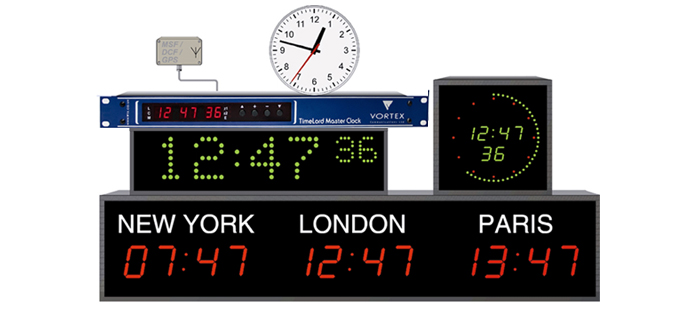
Our entire V-400 clock range has received an engineering and design refresh to provide enhanced operability, lower power consumption and additional features. The displays themselves are clearer and infra-red remote control for setup is included as standard, as is stopwatch operation.
Three ranges are now available – all can free-run but their locking capabilities are different; V-400A is designed for slave use with a TimeLord Master Clock plus it has optional input interfaces available (EBU and IRIG for example) for slave connectivity to external systems; V-400N has an Ethernet interface for NTP locking to a time source on the same subnet such as the TimeLord-Net but also NTP servers on the internet – and the new V-400NP has both NTP locking and PoE Power-over-Ethernet capability which means that mains power is not required – available for clocks up to 120mm high digits because of PoE power constraints (15W).
The V-400 series of multi-function digital time displays provide a reliable and accurate display of time for professional applications with an extensive range of user-programmable features and a choice of temperature, stopwatch or time using the infra-red controller. They are suitable for stand-alone use or can be used in centrally-synchronized master clock systems. There are a large number of digit size options available catering for maximum viewing distances of between 10 and 100 metres. Clocks with 7-segment digits have HH:MM:SS the same size whilst the dot-matrix clocks display the seconds in slightly smaller-size characters (see images below).
All our V-400 series clocks can do the following:
- Free-run locked to their own internal oscillator to within a couple of seconds per month
- Be locked to an off-air signal such as DCF or GPS using an optional receiver system
- Be equipped with an impulse interface to be locked to an impulse system (1 second, 1/2 minute or 1 minute impulses)
- Be locked to a Master Clock
- Show one of 15 Master Clock time zones
- Be used as a stopwatch / up-down counter with optional control panel
- Be equipped with an optional Master module to lock up to 9 more clocks all showing the same time
- Are set up either by pushbuttons or Infra-Red Handset
- Be equipped with an optional EBU interface to lock to EBU timecode
- Be equipped with an optional IRIG interface to lock to IRIG timecode
- Have automatic brightness plus 7 fixed brightness's
- Be equipped with an NTP Network Interface to lock to NTP on a network (factory-fitted - becomes .N)
- Be equipped with an NTP interface with PoE Power over Ethernet (factory-fitted - becomes .NP) for clocks with digits up to 120mm high
- Switch between time and temperature (requires optional V-406 sensor)
They are all available in surface-mount cases for attaching to solid surface (.S), Flush Panel Mount (.FP) where the clock is pushed in from the front through the panel and fixed from the rear, solid wallmount case with back-box (.FB), ceiling suspended with either single-sided (.SS) or double-sided displays (.DS) - plus they are available in Red (.R), Green (.G) and normally Yellow (.Y) and Blue (.B) also (depending on model) and for some models, Ultra-Brite Red (.UR), Yellow (.UY) or White (.UW).

Standard case colour is Black (.BL) - with Silver (.SI) also available at no extra cost. Other colour cases are also available to special order at modest extra cost including white (.WH) the range above and also RAL colours.
MAXIMUM RECOMMENDED VIEWING DISTANCES
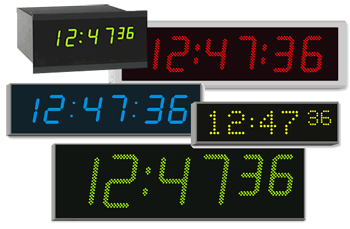
- 14mm high 7-segment characters – viewing distance is 6m / 20ft
- 20mm high 7-segment characters – viewing distance is 10m / 33ft
- 50mm high dot matrix characters - viewing distance is 20m / 65ft
- 57mm high 7-segment - viewing distance 25m / 80ft
- 100mm high 7-segment - viewing distance 50m / 160ft
- 120mm high dot matrix characters - viewing distance 50m / 160ft
- 170mm high 7-segment - viewing distance 80m / 260ft
- 220mm high 7-segment - viewing distance 100m / 325ft
The V-400 series clocks can be synchronised from many different external sources, including radio and satellite time signals, together with various time codes and impulse signals. The principle advantage of systems which use a time code rather than an impulse signal for controlling a network of slave clocks are
- The time code enables the slave clock to automatically self-set to the correct time on installation, following failures of the mains power supply or in the event of system maintenance.
- Seasonal time changes will normally take place within a few seconds, rather than at the delayed rate typical of an impulse system.
- The slave clocks will not, in normal circumstances, show an incorrect time due to missed impulses.
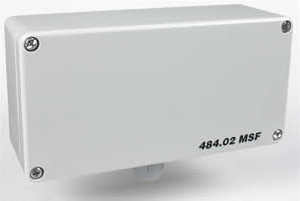
Off-Air References
All V-400 series displays can be locked to an off-air reference which may be terrestrial (for example MSF or DCF) or satellite (GPS). A master module V-404M can be installed inside single zone displays to provide 482 code output to up to 9 more displays all showing the same time without the need for a TimeLord Master Clock. V-47x series multi-zone displays have in-built master modules which provide multi-zone 482 time data to allow a number to be locked together all showing the same times. For Terrestrial (radio) synchronization, see the V-484 section and for GPS synchronization, see the V-488 section.
482 Multi-Zone Time & Date Code
The 482 Time & Date Code has been developed for controlling electronic clocks, using a single cable pair data interconnection, in electrically noisy environments and over considerable distances. A unique feature of the 482 code format is the ability to control slave clocks or time zone displays showing time in up to fifteen different synchronised time zones using a simple low-specification single cable pair.
482 code is transmitted at 4-24v amplitude and at 50 bits per second data rate. The signal is virtually immune from electro-magnetic interference. Up to 100 slave clocks can be controlled by a single unbuffered TimeLord master clock at distances of up to several km.
A 400 series clock fitted with a 404.M local master code output module, may be also used as a master clock in a small clock system. Up to ten other 400 series slave clocks may be controlled, displaying time in a single time zone, at distances of up to 400m.
NTP Network Time Protocol Synchronization
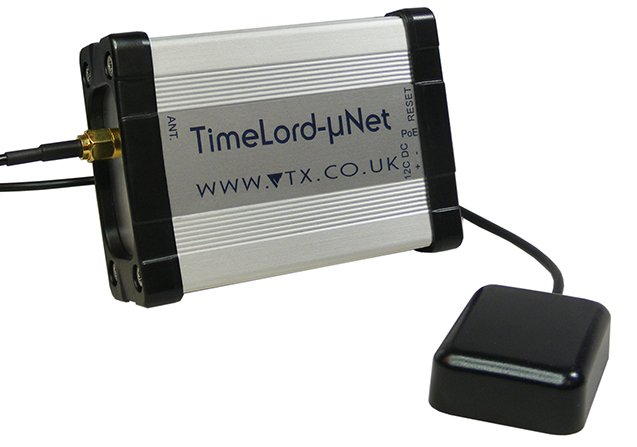
Most V-400 series displays can be equipped with an NTP network interface (factory-fitted) to allow locking to an NTP time server on the same network such as our TimeLord-Net and TimeLord-µNet.
Alternate & Single Polarity Impulses
The majority of conventional analogue slave clocks are controlled by impulse master clock systems using alternate polarity impulses of 24v amplitude. Impulses, typically of one half to one second duration, may be sent every second, every half minute or every minute depending on the clock mechanism. The transmission of impulses is either stopped or speeded up to effect seasonal or other time corrections. The slave clocks are connected in parallel across the signal cable from the master clock.
Some older systems use higher impulse voltages of up to 60v. Other systems use single polarity impulses, series interconnection of the slave clocks and 'hourly correction' pulses. V-400 series digital clocks, calendar clocks and time zone displays may be programmed to be synchronised by both single and alternate polarity impulses at a one second, half minute or one minute repetition rate providing that the impulses are from 6-48v amplitude and intended for parallel connection.
An optional internal V-404.P interface module is available to enable V-400 clocks to be used with impulse master clocks. V-400 series units may be operated from 60v alternate polarity signals if a 3K3 1W resistor is fitted in series with the clock across the signal line. Standard V-400 clocks will NOT operate correctly when connected to 'hourly correction' systems.
EBU/SMPTE Time Code

EBU/SMPTE time code is used in broadcast applications for 'stamping' time information on recordings and for the control of clocks and other intelligent systems. EBU time code is used in PAL and SECAM applications at 25 frames per second. SMPTE is the American standard for use with 30fps NTSC systems. The signal data is 2000 bits per second for SMPTE with each frame of data comprising 80 bits. The EBU standard defines the format for hours, minutes and seconds information. Date information can be added to the signal in a number of formats within 'user bit' areas.
400 series clocks fitted with the 404.E internal interface module may be programmed to decode the two most popular date formats for either EBU or SMPTE code transmitted within ±20% of the standard speed. When using 400 series calendar clocks synchronised by EBU/SMPTE time code, please ensure that the EBU date code format is compatible with the 400 calendar clock.
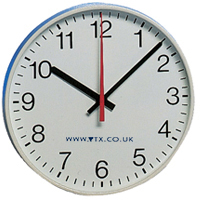
IRIG-B/AFNOR NFS 87 500
IRIG-B is one of a series of time codes originally developed in the 1940s by the International Range Instrumentation Group (IRIG) for recording time information on magnetic tape and wire for rocket test range instrumentation purposes. IRIG-B code is normally transmitted at a 100Hz bit rate amplitude modulated on a 1KHz carrier, where the amplitude of a '1' bit is three times that of an '0' bit. The IRIG-B code contains day-of-year and hours, minutes and seconds information. AFNOR NFS 87 500 time code is a development of IRIG-B which is widely used in Europe and contains additional day, day-of-month and year information.
All 400 clocks and calendar clocks may be synchronised with either IRIG-B or AFNOR NFS 87 500 time code when fitted with the optional 404.I internal interface module.
RS232 & RS485 (RS422)
RS232 and RS485 are international standards for the transmission of information, usually as ASCII characters, between intelligent equipment. RS232 is intended for short distance transmission, using un-balanced lines, between one master and one slave. The latest standards specify a maximum driven capacitance of 2500pF rather than a specific line length and it is usually possible, at lower data rates, to control several slave units within a small area.
RS485 (RS422) is intended for use in multi-slave applications using a balanced line. A single master will control up to 32 slaves, using a correctly terminated single twisted pair cable, at distances up to 1000m. The earlier RS422 standard may be regarded as interchangeable with RS485 except for a limit of 10 slaves.
The 404.2 (RS232) and 404.4 (RS422/485) internal interface modules for the 400 series clocks and calendar clocks allow either:
- The remote setting or synchronisation of 400 series clocks by computers using one of three data formats.
- The transmission of a serial ASCII time message, either every second or 'on demand', in one of seven data formats. The 'on demand' mode may be triggered by the receipt by the clock of an ASCII character (RS232 only) or by the closure of an external voltage free switch connected to the clock. Each message may be transmitted or received at 1200, 2400, 4800 or 9600 baud, seven or eight data bits and at odd or even parity.
It is very important that both the 400 series clock and the connected computer or other equipment are using the same signal standard, recognise the data format and are set to the correct baud rate, bit length, parity and number of stop bits.
Environmental Parameters
- Operating temperature: 0-50°C
- Relative Humidity: 0% to 95% (non-condensing).
V-400 series digital clocks and TimeLord Master Clocks, when used in accordance with our recommendations, comply with the European Community Electromagnetic Compatibility Directive 2004/108/EC, Low Voltage Directive 2006/95/EC and RoHS2 Directive 2011/65/EU and conform to the following standards:
- EN 50121-4-2006
- EN 61000-6-2:2005
- EN 61000-6-4:2007+A1:2011
- EN 55022:2010
- EN55024:2010
- EN 60950-1:2006
Click here for further details: Clocks & Displays - TimeLord-Lite - TimeLord-Net - TimeLord-MTG
Manuals: TimeLord - Single-Zone Displays - Multi-Zone v1 Displays - Multi-Zone v2 Displays





